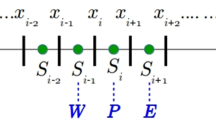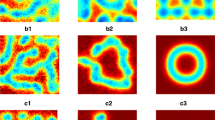Abstract
Reaction-telegraph equation (RTE) is a mathematical model that has often been used to describe natural phenomena, with specific applications ranging from physics to social sciences. In particular, in the context of ecology, it is believed to be a more realistic model to describe animal movement than the more traditional approach based on the reaction-diffusion equations. Indeed, the reaction-telegraph equation arises from more realistic microscopic assumptions about individual animal movement (the correlated random walk) and hence could be expected to be more relevant than the diffusion-type models that assume the simple, unbiased Brownian motion. However, the RTE has one significant drawback as its solutions are not positively defined. It is not clear at which stage of the RTE derivation the realism of the microscopic description is lost and/or whether the RTE can somehow be ‘improved’ to guarantee the solutions positivity. Here we show that the origin of the problem is twofold. Firstly, the RTE is not fully equivalent to the Cattaneo system from which it is obtained; the equivalence can only be achieved in a certain parameter range and only for the initial conditions containing a finite number of Fourier modes. Secondly, the Dirichlet type boundary conditions routinely used for reaction-diffusion equations appear to be meaningless if used for the RTE resulting in solutions with unrealistic properties. We conclude that, for the positivity to be regained, one has to use the Cattaneo system with boundary conditions of Robin type or Neumann type, and we show how relevant classes of solutions can be obtained.




Similar content being viewed by others
Notes
Here we are considering “dispersal” in a generic sense: movement along a certain path.
The counterpart situation where the particles are destroyed at the boundaries is described by the condition of no outgoing density at the borders, which is satisfied if \(u_{-} \left( 0, \zeta \right) = u_{+} \left( 1, \zeta \right) = 0\). The Robin set of conditions \(u \left( 0, \zeta \right) = j \left( 0, \zeta \right) \) and \(u \left( 1, \zeta \right) = -j \left( 1, \zeta \right) \) is only marginally different from the one used in the text, thus generating similar results.
The appearance of Eq. (45) can also be understood as a result of the boundary condition at \(z=0\) being implemented for the spatial and temporal parts independently: if we impose that \(U \left( 0\right) = J \left( 0\right) \), we obtain \(C_{1} = C_{2}\) and \(C_{4} = -C_{3}\); now the temporal parts must satisfy \(\Psi \left( \zeta \right) = - \Phi \left( \zeta \right) \), which generates equation (45).
References
Hastings, A.: An ecological theory journal at last. Theor. Ecol. 1, 1–4 (2008)
Hastings, A.: Population Biology: Concepts and Models. Springer-Verlag, New York (1997)
Kot, M.: Elements of Mathematical Ecology. Cambridge University Press, Cambridge (2001)
Mangel, M.: The Theoretical Biologist’s Toolbox: Quantitative Methods for Ecology and Evolutionary Biology. Cambridge University Press, Cambridge (2006)
Smith, J.M.: Models in Ecology. Cambridge University Press, Cambridge (1974)
Pyke, G.H.: Understanding movements of organisms: it’s time to abandon the Levy foraging hypothesis. Methods in Ecology and Evolution 6, 1–16 (2015)
Kareiva, P.M.: Local movement in herbivorous insecta: applying a passive diffusion model to mark-recapture field experiments. Oecologia 57, 322–327 (1983)
Bearup, D., Benefer, C.M., Petrovskii, S.V., Blackshaw, R.: Revisiting Brownian motion as a description of animal movement: a comparison to experimental movement data. Methods Ecol. Evol. 7, 1525–1537 (2016)
Hastings, A., Cuddington, K., Davies, K.F., Dugaw, C.J., Elmendorf, S., Freestone, A., Harrison, S., Holland, M., Lambrinos, J., Malvadkar, U., Melbourne, B.A., Moore, K., Taylor, C., Thomson, D.: The spatial spread of invasions: new developments in theory and evidence. Ecol. Lett. 8, 91–101 (2005)
Shigesada, N., Kawasaki, K.: Biological Invasions: Theory and Practice. Oxford University Press, Oxford (1997)
Skellam, J.G.: Random dispersal in theoretical populations. Biometrika 38, 196–218 (1951)
Hastings, A., Harisson, S., McCann, K.: Unexpected spatial patterns in an insect outbreak match a predator diffusion model. Proc. R. Soc. Lond. B 264, 1837–1840 (1997)
Malchow, H., Petrovskii, S.V., Venturino, E.: Spatiotemporal Patterns in Ecology and Epidemiology: Theory, Models, Simulations. CRC Press, Boca Raton (2008)
Meron, E.: Nonlinear Physics of Ecosystems. CRC Press, Boca Raton (2015)
Kareiva, P.M., Shigesada, N.: Analyzing insect movement as a correlated random walk. Oecologia 56, 234–238 (1983)
Othmer, H.G., Dunbar, S.R., Alt, W.: Models of dispersal in biological systems. J. Math. Biol. 26, 263–298 (1988)
Goldstein, S.: On diffusion by discontinuous movements, and on the telegraph equation. Q. J. Mech. Appl. Math. 4, 129–156 (1951)
Kac, M.: A stochastic model related to the telegraph’s equation. Rocky Mt. J. Math. 4, 497–509 (1956)
Joseph, D.D., Preziosi, L.: Heat waves. Rev. Mod. Phys. 61, 41–73 (1989)
Mendez, V., Fedotov, S., Horsthemke, W.: Reaction-Transport Systems: Mesoscopic Foundations, Fronts, and Spatial Instabilities. Springer, Berlin (2010)
Weiss, G.H.: Some applications of persistent random walks and the telegrapher’s equation. Physica A 311, 381–410 (2002)
Masoliver, J., Lindenberg, K.: Continuous time persistent random walk: a review and some generalizations. Eur. Phys. J. B 90, 107 (2017)
Angelani, L.: Run-and-tumble particles, telegrapher’s equation and absorption problems with partially reflecting boundaries. J. Phys. A 48, 495003 (2015)
Malakar, K., Jemseena, V., Kundu, A., Kumar, K.V., Sabhapandit, S., Majumdar, S.N., Redner, S., Dhar, A.: Steady state, relaxation and first-passage properties of a run-and-tumble particle in one-dimension. J. Statis. Mech. 2018, 043215 (2018)
Evans, M.R., Majumdar, S.N.: Run and tumble particle under resetting: a renewal approach. J. Phys. A 51, 475003 (2018)
Dhar, A., Kundu, A., Majumdar, S.N., Sabhapandit, S., Schehr, G.: Run-and-tumble particle in one-dimensional confining potential: steady state, relaxation and first passage properties. Phys. Rev. E 99, 032132 (2019)
Le doussal, P., Majumdar, S.N., Schehr, G.: Non-crossing run and tumble particles on a line. Phys. Rev. E 100, 012113 (2019)
Berg, H.C.: E. coli in Motion. Springer, Berlin (2014)
Hadeler, K.P.: Reaction transport systems in biological modelling. In Mathematics Inspired by Biology, pp. 95–150. Springer, Berlin (1999)
Holmes, E.E.: Are diffusion models too simple? A comparison with telegraph models of invasion. Am. Nat. 142, 779–795 (1993)
Dunbar, S.R., Othmer, H.G.: On a nonlinear hyperbolic equation describing transmission lines, cell movement, and branching random walks. In Nonlinear Oscillations in Biology and Chemistry, pp. 274–289. Springer, Berlin (1986)
Dunbar, S.R.: A branching random evolution and a nonlinear hyperbolic equation. SIAM J. Appl. Math. 48, 1510–1526 (1988)
Mainardi, F.: Signal velocity for transient waves in linear dissipative media. Wave Motion 5, 33–41 (1983)
Sobolev, S.L.: Transport processes and travelling waves in systems with local nonequilibrium. Sov. Phys. Usp. 34(3), 217–229 (1991)
Lakestani, M., Saray, B.N.: Numerical solution of telegraph equation using interpolating scaling functions. Comput. Math. Appl. 60, 1964–1972 (2010)
Gilding, B.H., Kersner, R.: Wavefront solutions of a nonlnear telegraph equation. J. Differ. Equ. 254, 599–636 (2013)
Buono, P.-L., Eftimie, R.: Symmetries and pattern formation in hyperbolic versus parabolic models of self-organised aggregation. J. Math. Biol. 71, 847–881 (2015)
Artale Harris, P., Garra, R.: Nonlinear heat conduction equations with memory: physical meaning and analytical results. J. Math. Phys. 58, 063501 (2017)
Di Crescenzo, A., Martinucci, B., Zacks, S.: Telegraph process with elastic boundary at the origin. Methodol. Comput. Appl. Prob. 20, 333–352 (2018)
Giusti, A.: Dispersion relations for the time-fractional Cattaneo-Maxwell heat equation. J. Math. Phys. 59, 013506 (2018)
Sobolev, S.L.: On hyperbolic heat-mass transfer equation. Int. J. Heat & Mass Transfer 122, 629–630 (2018)
Hajipour, M., Jajarmi, A., Malek, A., Baleanu, D.: Positivity-preserving sixth-order implicit finite difference weighted essentially non-oscillatory scheme for the nonlinear heat equation. Appl. Math. Comput. 325, 146–158 (2018)
Niwa, H.: Migration dynamics of fish schools in heterothermal environments. J. Theor. Biol. 193, 215–231 (1998)
Murray, A.G., O’Callaghan, M., Jones, B.: Simple models of massive epidemics of herpesvirus in Australian (and New Zealand) pilchards. Environ. Int. 27, 243–248 (2001)
Ortega-Cejas, V., Fort, J., Mendez, V.: The role of the delay time in the modeling of biological range expansions. Ecology 85, 258–264 (2004)
Hillen, T.: Existence theory for correlated random walks on bounded domains. Can. Appl. Math. Q. 18, 1–40 (2010)
Hillen, T., Swan, A.: The diffusion limit of transport equations in biology. In Mathematical models and methods for living systems, pp. 73–129. Springer, Berlin (2014)
Garabedian, P.R.: Partial Differential Equations. AMS Chelsea Publishing, Providence (1998)
Alharbi, W.G., Petrovskii, S.V.: Critical domain problem for the reaction-telegraph equation model of population dynamics. Mathematics 6, 59 (2018)
Cirilo, E., Petrovskii, S.V., Romeiro, N., Natti, P.: Investigation into the critical domain problem for the reaction-telegraph equation using advanced numerical algorithms. Int. J. Appl. Comput. Math. 5, 54 (2019)
Acknowledgements
This work was supported by The Royal Society (UK) through the Grant No. NF161377 (to P.F.C.T and S.V.P.). The publication has been prepared with the support of the “RUDN University Program 5-100” (to S.V.P.).
Author information
Authors and Affiliations
Corresponding author
Additional information
Communicated by Irene Giardina.
Publisher's Note
Springer Nature remains neutral with regard to jurisdictional claims in published maps and institutional affiliations.
Rights and permissions
About this article
Cite this article
Tilles, P.F.C., Petrovskii, S.V. On the Consistency of the Reaction-Telegraph Process Within Finite Domains. J Stat Phys 177, 569–587 (2019). https://doi.org/10.1007/s10955-019-02379-0
Received:
Accepted:
Published:
Issue Date:
DOI: https://doi.org/10.1007/s10955-019-02379-0




